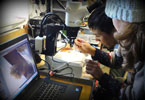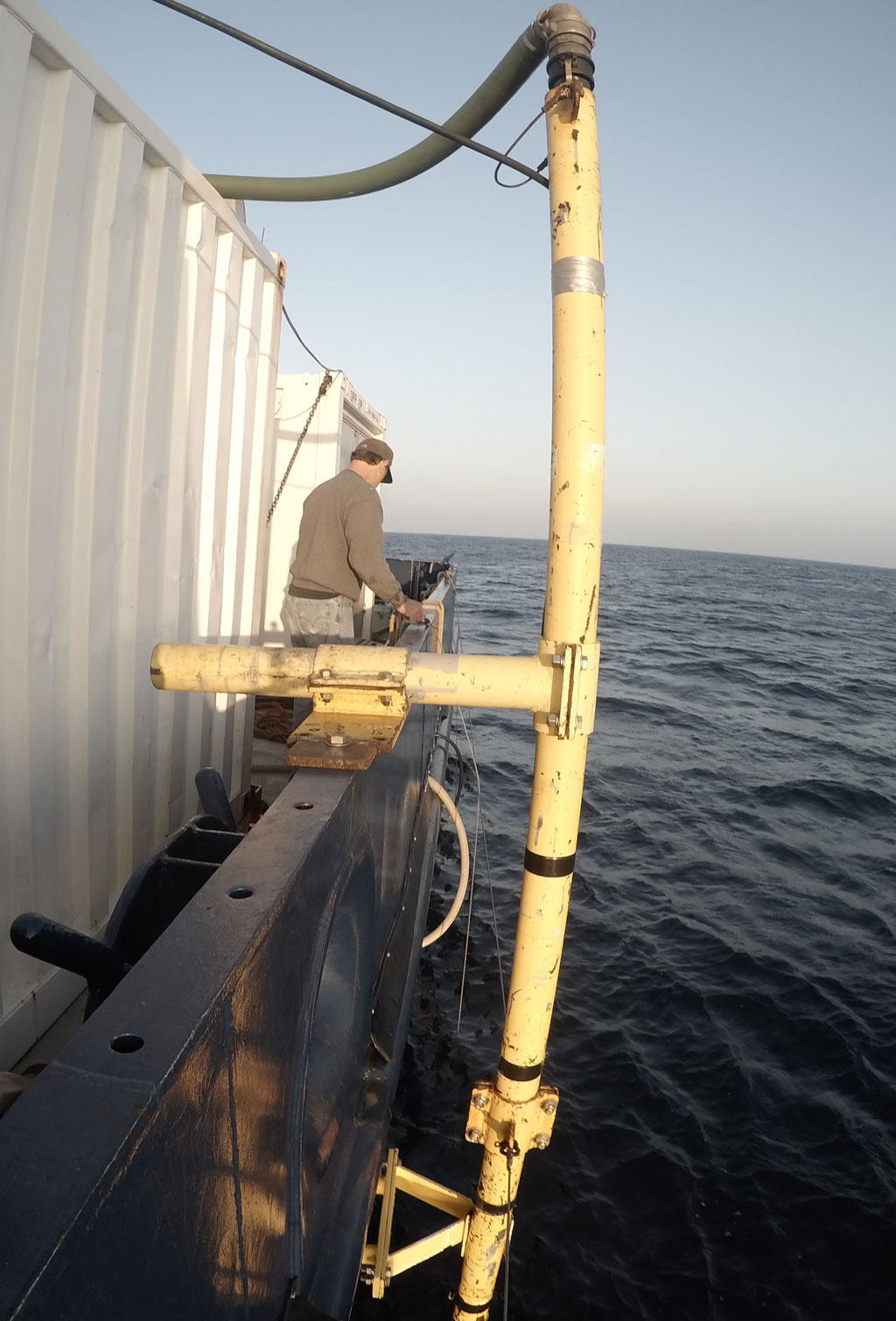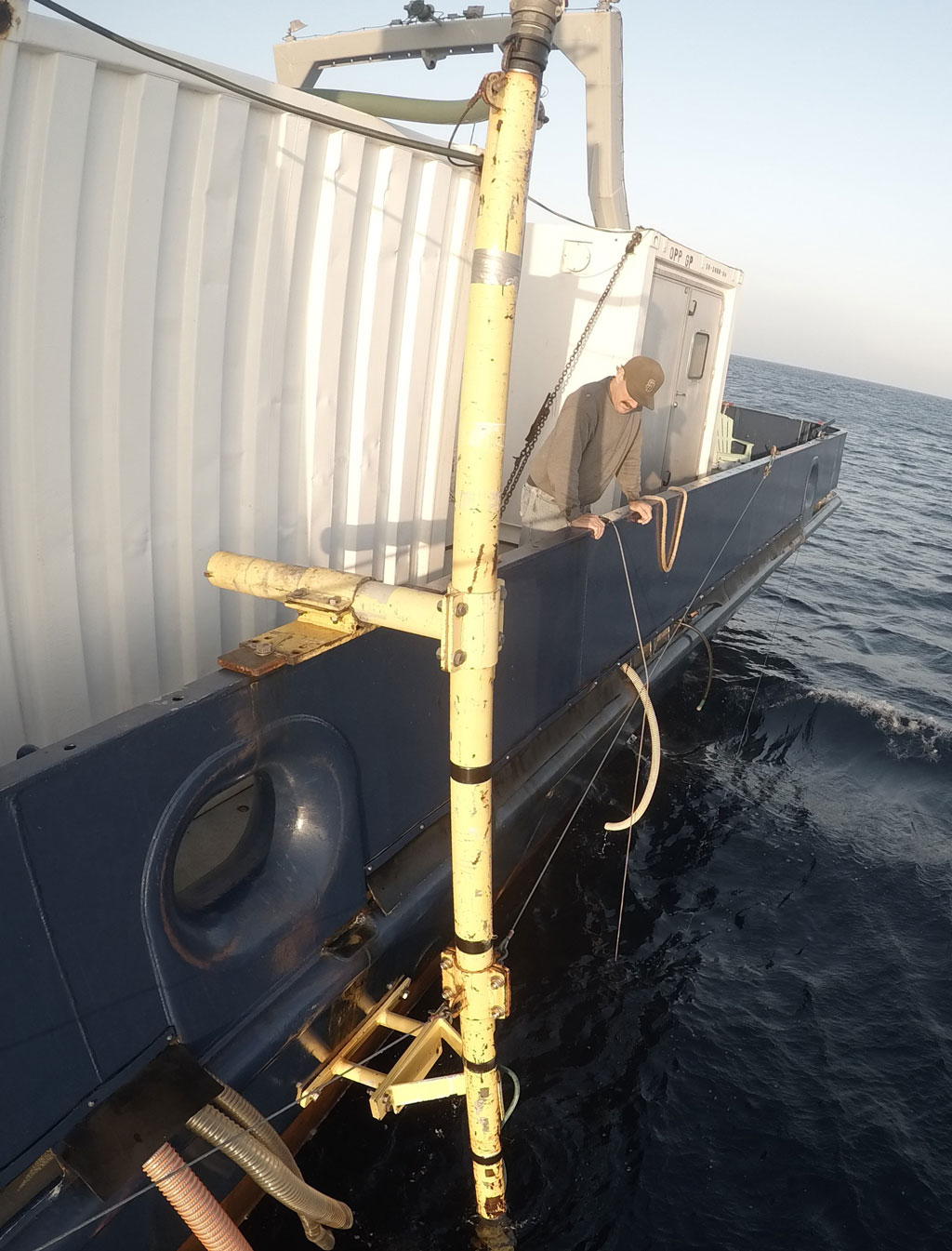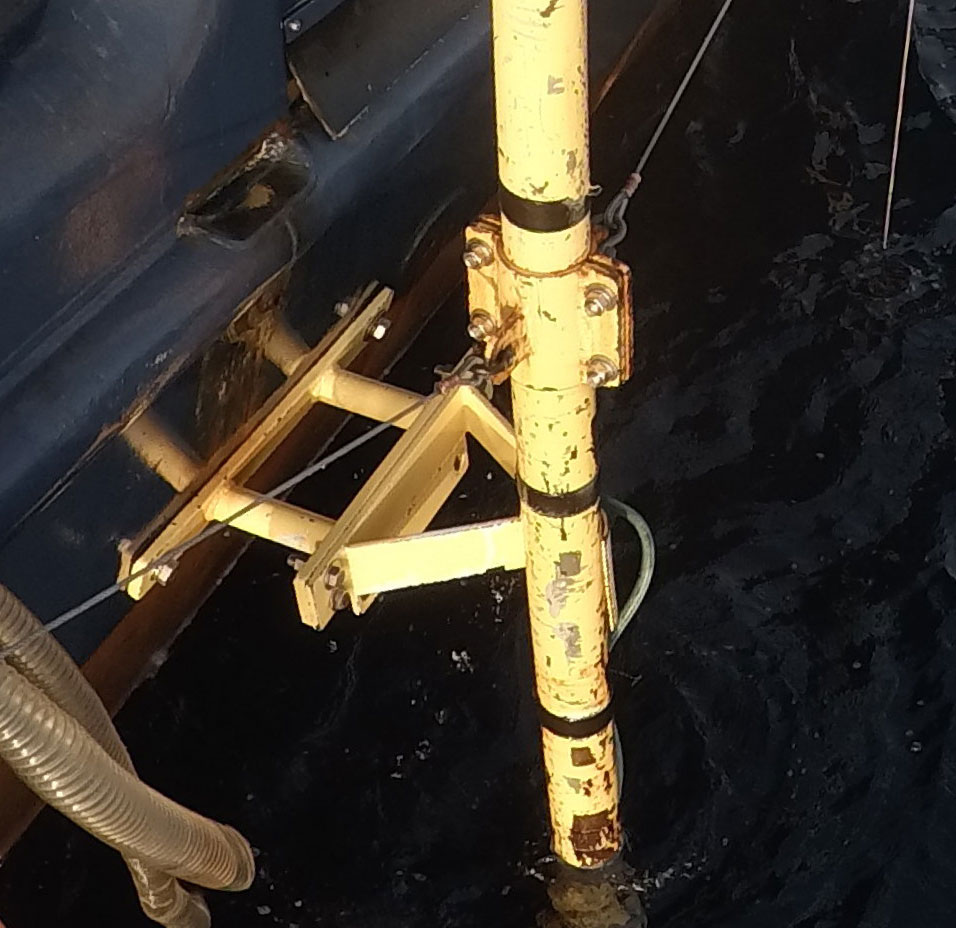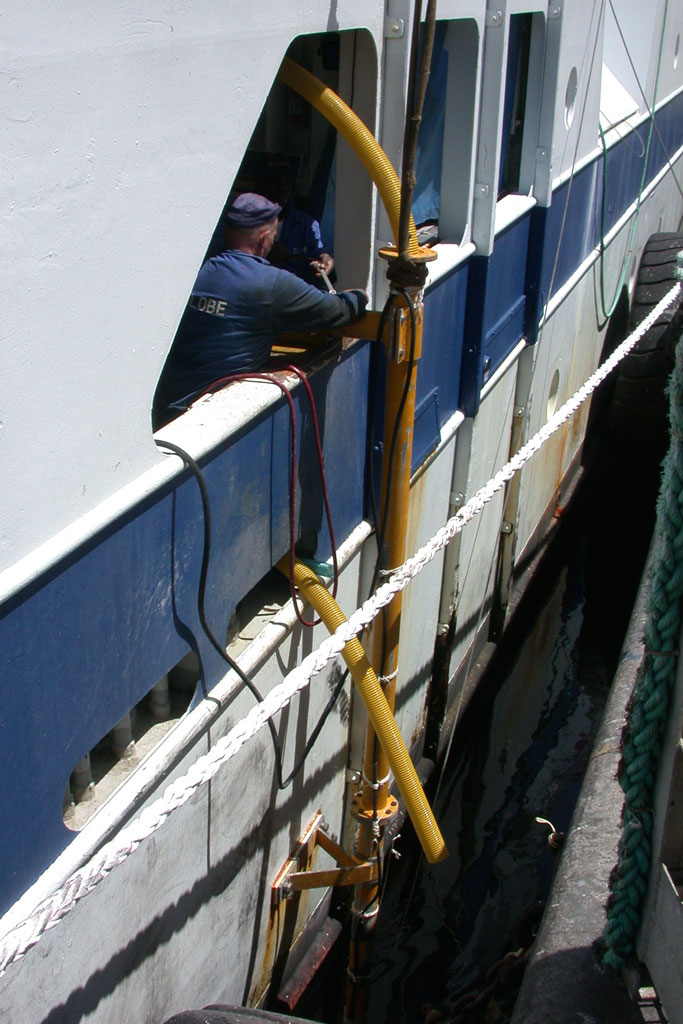Volunteering
Interested in volunteering for an oceanographic cruise? Volunteers are recruited to help deploy equipment, collect data, and draw & analyze seawater samples.
Read more...
A. Typical Cruise Chemical Inventory
|
Common Name of Material |
Qty |
Notes |
Trained Individual |
Spill control |
|
Ethyl alcohol (95%) |
80L (in 20L cans) |
UN1170, Waste contained and disposed of by SWFSC at end of project. Stored in fume hood |
Bryan Overcash, Amy Hays |
F |
|
Formaldehyde solution (37%) |
20L |
No waste. Stored in fume hood |
Bryan Overcash, Amy Hays |
F |
|
Tris buffer |
500ml |
Stored in Chem lab |
Bryan Overcash, Amy Hays |
F |
|
Sodium borate powder |
500gr |
Stored in Chem lab |
Bryan Overcash, Amy Hays |
F |
|
HCL (1.2N) |
4L |
UN1789, No waste. Stored in chem lab. |
David Wolgast |
A |
|
Sulfuric acid (10 Normal) |
4L |
Stored in Chem lab, waste neutralized by base in assay |
David Wolgast |
A |
|
Acetone (90%) |
7L |
UN1090, Waste contained and disposed of by SIO at end of project. Stored chem locker. |
David Wolgast |
F |
|
Mangannous Chloride |
4L |
No waste. stored in chem locker |
David Wolgast |
A |
|
Sodium Hydroxide/Sodium Iodide |
4L |
UN1824, Waste neutralized by acid in assay. Stored in chem locker |
David Wolgast |
A |
|
Ethanol (95%) |
1L |
UN1170, No waste. Stored in Constant environment room |
David Wolgast |
F |
|
Ecolume Scintillation Fluid |
2.5L |
No waste. Stored chem locker. |
David Wolgast |
F |
|
HCL (12N) |
150ml |
No waste. Stored in wet lab/Dropper bottles with secondary containment |
Shonna Dovel |
A |
|
Isopropyl Alcohol (91%) |
30ml |
No waste. Stored in wet lab/Dropper bottles with secondary containment |
Shonna Dovel |
A |
|
Liquid Nitrogen |
50L Dewar |
No waste. Stored wet lab |
Shonna Dovel |
A |
|
Acetone (90%) |
7L |
No waste. Stored in wet lab and -80 freezer with secondary containment |
Shonna Dovel |
F |
|
HCL (1N) |
400ml |
No waste. Stored in wet lab/Dropper bottles with secondary containment |
Shonna Dovel |
A |
|
0.01 mg/ml DAPI 4’,6-Diamidino-2-Phenylindole,Dihydrochloride |
4x1-ml aliquots |
Stored in Chem lab. Concentrated DAPI in freezer with secondary containment |
Shonna Dovel |
A |
|
Buffered Formalin (10%) |
2L |
Stored in Chem lab fume hood with secondary containment |
Shonna Dovel |
F |
|
Alkaline Lugol’s fixative (100%) |
250ml |
Stored in Chem lab refer with secondary containment |
Shonna Dovel |
F |
|
Paraformaldehyde (10%) |
.5L |
Stored in Chem lab refer with secondary containment |
Shonna Dovel |
F |
|
Proflavin (0.033%) |
250ml |
Stored in Chem lab refer with secondary containment |
Shonna Dovel |
F |
|
Sodium Thiosulfate (0.190M) |
250ml |
Stored in Chem lab refer with secondary containment |
Shonna Dovel |
F |
|
Basic Lugol’s fixative (100%) |
500ml |
Stored in Chem lab fume hood with secondary containment |
Shonna Dovel |
F |
|
Ammonium Molybdate |
75g |
No waste. Stored in Chem lab |
David Wolgast |
D |
|
Ammonium Sulfate |
0.1322g |
No waste. Stored in Chem lab |
David Wolgast |
D |
|
Ascorbic acid |
46g |
No waste. Stored in Chem lab |
David Wolgast |
D |
|
Brij-35 (15%) |
15g |
No waste. Stored in Chem lab |
David Wolgast |
D |
|
Imidazole |
8g |
No waste. Stored in Chem lab |
David Wolgast |
D |
|
Copper Sulfate |
2g |
No waste. Stored in Chem lab |
David Wolgast |
D |
|
N-(1-naphthyl) ethylenediamine dihydrochl |
2g |
No waste. Stored in Chem lab |
David Wolgast |
D |
|
Cadmium Coil |
3g |
No waste. Stored in Chem lab |
David Wolgast |
D |
|
Oxalic acid |
100g |
No waste. Stored in Chem lab |
David Wolgast |
D |
|
Sodium dodecyl sulfate |
24g |
No waste. Stored in Chem lab |
David Wolgast |
A |
|
Potassium antimony tartrate |
0.34g |
No waste. Stored in Chem lab |
David Wolgast |
D |
|
Potassium Phosphate |
0.8g |
No waste. Stored in Chem lab |
David Wolgast |
D |
|
Sodium chloride |
850g |
No waste. Stored in Chem lab |
David Wolgast |
D |
|
Sodium Nitrite |
1.4g |
No waste. Stored in Chem lab |
David Wolgast |
D |
|
Sodium hydrogen carbonate |
15g |
No waste. Stored in Chem lab |
David Wolgast |
D |
|
Sodium Hydroxide |
10g |
No waste. Stored in Chem lab |
David Wolgast |
D |
|
Sodium Hydroxide |
0.1L |
No waste. Stored in Chem lab |
David Wolgast |
A |
|
Ammonia Sulphate |
1L |
No waste. Stored in Chem lab |
David Wolgast |
A |
|
Sodium sulfite |
2.4g |
No waste. Stored in Chem lab |
David Wolgast |
D |
|
Sulfanilamide |
20g |
No waste. Stored in Chem lab |
David Wolgast |
D |
|
O-phthalaldehyde |
4g |
No waste. Stored in Chem lab |
David Wolgast |
D |
|
Ethanol |
1500ml |
No waste. Stored in Chem lab |
David Wolgast |
F |
|
HCL (dilute 1.2N) |
2.5L |
No waste. Stored in Chem lab |
David Wolgast |
A |
|
HCL (conc. 12N) |
4L |
No waste. Stored in Chem lab |
David Wolgast |
A |
C. Chemical safety and spill response procedures
A: ACID/Bases
· Wear appropriate protective equipment and clothing during clean-up. Keep upwind. Keep out of low areas.
· Ventilate closed spaces before entering them.
· Stop the flow of material, if this is without risk. Dike the spilled material, where this is possible.
· Large Spills: Dike far ahead of spill for later disposal. Use a non-combustible material like vermiculite, sand or earth to soak up the product and place into a container for later disposal.
· Small Spills: Wipe up with absorbent material (e.g. cloth, fleece). Clean surface thoroughly to remove residual contamination.
· Never return spills in original containers for re-use.
· Neutralize spill area and washings with soda ash or lime. Collect in a non-combustible container for prompt disposal.
· J. T. Baker NEUTRASORB® acid neutralizers are recommended for spills of this product.
F: Formalin/Formaldehyde/Ethanol/Acetone
· Ventilate area of leak or spill. Remove all sources of ignition.
· Wear appropriate personal protective equipment.
· Isolate hazard area. Keep unnecessary and unprotected personnel from entering. Contain and recover liquid when possible.
· Use non-sparking tools and equipment. Collect liquid in an appropriate container or absorb with an inert material (e. g., vermiculite, dry sand, earth), and place in a chemical waste container.
· Do not use combustible materials, such as saw dust.
D: Powdered and granular chemicals
· Wear appropriate protective equipment and clothing during clean-up. Keep upwind. Keep out of low areas.
· Sweep up dry chemical and place in a doubled zip lock bag.
· If contact with water occurs, use proper neutralizing agent prior to cleanup.
· Store in sealed container to be returned and disposed by UCSD EH&S.
Inventory of Spill Kit supplies
|
Product Name |
Amount |
Chemicals it is useful against |
Amount it can clean up |
|
Chemical Spill pads |
100 |
Formaldehyde, Alcohols |
110L |
|
Uni-Safe spill binder |
14 kg |
Formaldehyde, alcohols, acids |
120L |
Note: Please see attached Appendix 1.a. detailing spill control efforts for Scripps Institution of Oceanography.
 OSU R/V Oceanus; Cruise Planning Manual; OSU CEOAS;
OSU R/V Oceanus; Cruise Planning Manual; OSU CEOAS;
R/V OCEANUS is owned by the National Science Foundation and operated under a Cooperative Agreement by Oregon State University, College of Earth, Ocean & Atmospheric Sciences. The vessel is homeported in Newport, Oregon.
Oregon State University - CEOAS
Ship Operations
2020 SE OSU Drive
Newport, OR 97365-5275
Telephone: 541-867-0295
Fax: 541-867-02944
Note that this information is presented as-is, transcribed from the OSU RV Oceanus website Sept 2015. Please refer to the OSU Cruise Planning Manual for complete information.
For CalCOFI cruises on ships not equipped with built-in EK60 acoustic transponders or CUFES fish egg pumps, it is possible use to use SIO’s pole-mounted CUFES or EK60. The SIO system requires attaching (bolting or welding) a plate (roughly 6” x 24” x 1” steel), amidships just above the waterline, to which a standoff is bolted. Another standoff clamp is attached to the gunwale directly above the lower standoff, and two pairs of guy-wires run fore and aft. The welding of an attachment plate was performed on SIO ships at our Marine Facilities with a machine shop adjacent to the pier.
A similar installation was done on the RV Nansen (Norwegian ship off southern Africa in 2003) for CUFES (the Continuous Underway Fish Egg Sampler). Either CUFES or the EK60 makes use of the same standoff and gunwale installation. On the RV Nansen the gunwale clamp was welded to the gunwale but typically it is bolted to the gunwale. The RV New Horizon uses a pole-mounted CUFES system but the EK60 transducers are installed in the hull.
Port Hueneme
The Port of Hueneme in California, United States, is the only deep water harbor between Los Angeles and the San Francisco Bay area. Located in Ventura County on the Santa Barbara Channel, the port complexnot only serves international shipping businesses but is an operating facility of Naval Base Ventura County(NBVC).
CalCOFI workstations rely on a local area network and NAS data server (//seaserv2) to interact and exchange data at-sea. Essential workstations need to be setup & running on the network before the first CTD cast.
The essential workstations are:
- CTDBlade1 - primary CTD data acquisition computer running Windows7, Seasoft v7, CELogGPS event log, & CTDBackup; connected to the CTD deck unit. (Blue denotes CalCOFI in-house software).
- Seasoft (from seabird.com) is used to acquire real-time CTD data.
- CELogGPS runs in the background (or may be run on another nearby/KVM PC) so the CTD operator can generate the CTDatDepth event, recording 'GPS lat lon date time event# & activity' when the first bottle is tripped.
- After tripping the last, surface bottle & the CTD lands on deck, the deck pressure is written on the console ops form; Seasave data acquistion is stopped; the deck unit is turned off; then CTDBackup is run by pressing <Ctrl><Alt>B (shortcut key mapped in Windows to executes the CTDBackup program). This copies all cast files to a flash drive and generates a base file for the seawater sample log, CESL program, running on the wet-lab tablet computer. Note: any corrections to the cast's .mrk file should be done BEFORE pressing <CTRL><Alt>B ie duplicate markers erased or extra bottles without markers added.
- ZTree is used to print the .mrk & .prn files then move the CTD cast files to the archive directory when archiving; printouts are collated & put in the CTD notebook.
- Network color printer connectivity required.
-
CTDBlade2 - backup CTD data acquisition computer running Windows7 and METCapture; able to run Seasoft v7, CELogGPS, CTDBackup, & ZTree quickly if needed for CTD ops. All software settings for Seasoft, CTDBackup, & CELogGPS from CTDBlade1 should be mirrored onto CTDBlade2. When not being used for CTD ops, CTDBlade2 runs:
- METCapture which logs MET/SCS/GPS data to the Events dir on seaserv. METCapture will also generate the currpos.csv used by other event logging workstations on the network.
- pH logger - serial terminal capture program, only if pH is NOT integrated into MET.
- Network color printer connectivity required for CTD backup ops.
-
CESL-Tablet - Windows7, weatherproof tablet in the wet-lab, rosette sampling area runs:
- CESL: CalCOFI Electronic Sample Log program. CESL is used to log all seawater sample information, generate a chl sample filtration form, & analytical base files for use by other workstations-programs.
- CELogGPS may be run in the background for event monitoring & entry.
- Network color printer connectivity required.
-
ROXY (Intel NUC or Moneual-red) - small oxygen autotitrator pc running Windows7.
- Runs an ODF-developed, Labview Oxygen Autotitration program. If available, the autotitrator program will load draw temperatures and flask numbers from the sta 'box' file (###01.box; in the 'O2box' dir). CESL generates this file from the flask & draw T columns when saving the station log; ROXY's O2 box directory needs to be shared & writable over the network by CESL. ROXY's O2 box dir is usually mapped as O:\.
- Network color printer connectivity required.
-
PIC-Laptop - required only for prodo sta; on a networked workstation
- Run Almanac, a simple program that calculates LAN (local apparent noon; called "transit, azimuth:..." in the program) & civil twilight ("civil twilight ends") using the prodo incubation's estimated begin & end latitudes/longitudes.
- In DECODR, run the PIC: Productivity Integration Calculator module; enter the sta# (001-075), LAN & Civil Twilight (from step 1 Almanac output), secchi depth & cast type to generate the prodo experiment bottle depths. PIC will print the bottle depths to a network printer then saves the bottle numbers, adjusted for extra bottles, to the prd### file. CESL uses the prd### to highlight prodo bottles on the sample log. If prodo bottles are not highlighted, the CTD operator has forgotten to label the cast type as "PRODO" in the CTD header form, filled out at the start of the cast. Selecting 'PRODO' in CESL's cast-type box will fix this and load the prd### and highlight the depths.
- Network color printer connectivity required.
- EventLog-Tablet - on New Horizon, a networked, tablet pc running Windows 7 or XP and CELogGPS is mounted vertically (using a clipboard) in the aft-control winch shack. New Horizon crew will log all station activities for us, if requested. Some training of new (& old) crew may be necessary to get things started - update their initials in the initials.txt or watch.txt file (whichever is specified in CELogGPS.cfg). Events are displayed onscreen on all the event log program on the network so CTD operators should monitor entries and be sure all sta activities are recorded. On other ships, the event log tablet is installed near net operations. WiFi may be used if a strong signal is available.
Other workstations on the network:
-
FLog - Chl/Rad van workstation running the chlorophyll analysis program FLog; will preload a chl base file generated by CESL and save chl readings locally & to the chl dir on seaserv.
- Network color printer connectivity required.
- PSal - salt analysis computer running PSal, which will preload a salt base file generated by CESL. PSal will compare the bottle salt sample reading to CTD values from the sta.csv. A Local printer is preferred since PSal buffers each sample record. If desired or no local printer is available, the printfile may be manually printed after the run.
- Nuts - nutrient analysis laptop running SEAL Quattro software does not require a network connection to run nutrient samples. But it is desireable so nutrient data may be copied/backed-up to seaserv's nuts dir during the cruise for data-processing & quality-control. No printer connectivity is required but may also be desired.
SIO Chief Scientist Cruise Planning Guide
- Submit a cruise plan; post a cruise prospectus on calcofi.com
-
Contact resident technician group (This email address is being protected from spambots. You need JavaScript enabled to view it.) regarding cruise needs - crane, winch, loading, benches, securing vans & gear
- RV New Horizon 2-Van Setup: Chl/Rad & LTER; 3-Van Setup: Chl-Rad, LTER, & CUFES
- Pre-cruise meeting with MarFac et al - meet with New Horizon captain, MarFac, restechs, STS
- Isotope utilization form
-
One month before the cruise:
- Authorization Forms - Request to use isotopes aboard SIO vessels (SIO scientists): Fillable PDF form
- Download/complete/submit a cruise planning guide: XLS
- Loading plan for deck & interior spaces: This email address is being protected from spambots. You need JavaScript enabled to view it.
- Winch & wire needs: This email address is being protected from spambots. You need JavaScript enabled to view it.
- Notices to Mariners
- Clearance to work inside U.S. Navy operations area; Southern California Naval Operations page
-
Two week before the cruise:
- Complete/Submit Scientific Party list
-
Receive/submit participants forms:
- Alcohol, Drugs & Sexual Harassment Aboard SIO Vessels Form
- Physical Ability to Work at Sea Form
- Medical Questionaire (Optional but recommended for anyone with prescriptions)
- Travel Insurance
- UNOLS post-cruise assessment: Web-based form
SIO Chief Scientist Information Links
- Ship Operations (shipsked.ucsd.edu)
- Chief Scientist Manual
- Cruise Checklist
CalCOFI instrumentation and measurements have evolved over its 67+ year history. Additional seawater sampling, data collection and measurements are continually being added to the core hydrographic work. Here is a list of the current instrumentation, equipment, and measurements typically required for a CalCOFI cruise:
| Equipment | Org | Location | Ship requirement | Description |
| CTD-Rosette w/ 4-10L bottles | SIO | Quarterdeck | 4500m of ~0.322 conductive wire and winch w/ CTD lab junction box & GPS feed. Surface PAR & SBE 14 remote depth readout box are requested but can be provided by SIO-CalCOFI |
Typical CTD-rosette casts are to 515m (depth-permitting) but a 3500m deep cast may be performed at sta 90.80 & 80.80. |
| pCO2/pH Underway System | SIO | Wet Lab | Uncontaminated seawater, flow rate ~4L/min; GPS feed | Self-contained pCO2/pH data acquisition system collects sea surface pCO2, pH, TSG, GPS data |
| Weather/MET/SCS Underway System | Ship | Ship system | Meteorlogical & sea surface data system & display and/or feed from the ship | Weather and ship's underway data is collected for sea surface measurements and visual observings. |
| ALF: Adv Laser Fluorometer | SIO | Wet Lab | Uncontaminated seawater, flow rate ~1L/min |
Continuous underway analysis of phytoplankton pigment groups and variable fluorescence (Fv/Fm) |
| Bongo Net | NOAA | Quarterdeck | ~500m of ~0.25" hydro wire w/ stainless thimble termination & winch; 75lb weight (NOAA-provided) | Tow specifications: Ship speed ~2kts; using paired 505 um mesh nets w/ 71 cm diameter openings, 300 meters of wire out, depth permitting, descent rate of 50 m/min; then ascend at 20m/min w/ wire angles ~45 degrees. |
| PRPOOS Net | LTER | Quarterdeck | ~500m of ~0.25" hydro wire w/ stainless thimble termination & winch; 170lb weight (LTER-provided) | LTER 210m vertical net tow is performed at all stations on line 90.0 and 80.0 as well as stations out to and including station 70.0 on lines 86.7 and 83.3. Descent rate of 40 m/min, a terminal depth time of 20 secs then an ascent rate of 50 m/min |
| Pairovet Net | NOAA | Quarterdeck | ~500m of ~0.25" hydro wire w/ stainless thimble termination & winch; 100lb weight (NOAA-provided) | Vertical net tow fished from 70m to surface (depth permitting) using paired 25 cm diameter 150 µm mesh nets at stas out to and including 70.0. Pairovet tows require: descent rate of 70 m/min, a terminal depth time of 10 secs then an ascent rate of 70 m/min |
| Manta Net | NOAA | Quarterdeck | ~500m of ~0.25" hydro wire w/ stainless thimble termination & winch; 100lb weight (NOAA-provided) | Using a 505 µm mesh net on a frame with a mouth area of 0.1333 m². Tows are 15 mins in duration at a towing speed of approx 1.5 - 2.0 knots. Wire angles should be kept between 15° and 25°. |
| Secchi | SIO | Quarterdeck | ~500m of ~0.25" hydro wire w/ stainless thimble termination & winch; 100lb weight (NOAA-provided) | Measurements to determine the 1% light level are performed during daylight stations, weather-permitting. |
| Primary Productivity Incubation Experiment | SIO | Main or 01 Deck | Open deck space with unobstructed sun; surface seawater flow ~4+L/min during daylight hours | Each day of the cruise, a primary productivity incubation experiment is started with seawater samples collected from the CTD cast. Eighteen samples are drawn from six calculated light-level depths determined by the Secchi depth |
| Marine Mammal Acoustics | SIO | Main Deck | Empty-spool winch for marine mammal acoustics hydrophone deployments; deck or winch block for wire support, deployment & recovery; GPS feed in dry lab | During transit between daytime stations, a towed hydrophone array, monitored by an acoustician, records marine mammal vocalizations |
| CUFES | NOAA | Main Deck | Ship-provided CUFES system or deck space for NOAA's CUFES 10'x10' van; rail mount for CUFES pump pole and cabling; hull plate mounting bracket. | On Winter (~Jan), Spring (~Apr), and Summer (~Jul) CalCOFIs, the CUFES egg pump filters seawater from a depth of three meters. Seawater is pumped through an egg concentrator and sample are examined, preliminary egg counts are performed, and the samples are preserved for further analysis on-shore. |
| Fisheries Acoustics | NOAA | Ship system | Ship-provided EK60-80 & other frequency data are collected 7/24 | Multi-frequency acoustics are used to estimate the biomass and distribution of mesopelagic and epipelagic (sardine and anchovy) fishes as well as macrozooplankon and identify areas of enhanced productivity and concentration in the southern California Current. |
| ADCP | SIO | Ship system | Ship-provided ADCP data collection 7/24, synced with EK60-80 ping | ADCP continuous profiles of ocean currents and acoustic backscatter between 20 and 500 meters deep are measured along the shiptrack from a hull-mounted 150 kHz Acoustic Doppler Current Profiler (ADCP) |
| Visual Observations | SIO & Farallon Institute | Bridge wings or flying bridge | Bridge or flying bridge space for observers to do visual surveys during daylight transits; request bolted chairs, Big Eye mount, GPS feeds, wind-shield, bimini. What is unavailable can be installed by observers | During daylight transits marine mammal observers and bird observer will visually identify and quantify marine mammals and birds. |
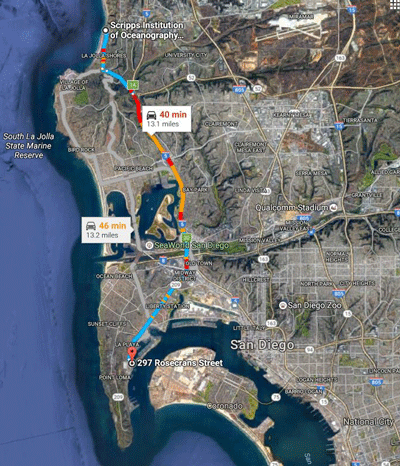 The Nimitz Marine Facility (MarFac) is the home port and technical support center for the Scripps Institution of Oceanography research fleet. Recently renovated, MarFac is the home of SIO's newest research vessel RV Sally Ride. RV Robert Gordon Sproul, RV Revelle, FLIP also berth here.
The Nimitz Marine Facility (MarFac) is the home port and technical support center for the Scripps Institution of Oceanography research fleet. Recently renovated, MarFac is the home of SIO's newest research vessel RV Sally Ride. RV Robert Gordon Sproul, RV Revelle, FLIP also berth here.
Please note that access to MarFac dockside & any of the research ships require a Transportation Worker's Identification Credential (TWIC) card or a TWIC escort.
Address: 297 Rosecrans Street, San Diego 92106-3505
From the airport:
- Drive southwest on North Harbor Drive
- Turn left on Rosecrans St
- Follow Rosecrans 1.4 miles to the Nimitz Marine Facility at 297 Rosecrans St. The entrance will be on the left, just before the entrance to Naval Base Point Loma.
From the Scripps Institution of Oceanography campus
- Begin by heading south on La Jolla Shores Drive
- Turn left on La Jolla Parkway
- Take the I-5 South for 8 miles
- Take exit 20 for the I-8 East, towards Rosecrans/El Centro.
- Stay in the right lane, and you will exit onto Camino Del Rio, which merges onto Rosecrans St.
- Follow Rosecrans 3.7 miles to the Nimitz Marine Facility at 297 Rosecrans St. The entrance will be on the left, just before the entrance to Naval Base Point Loma.

